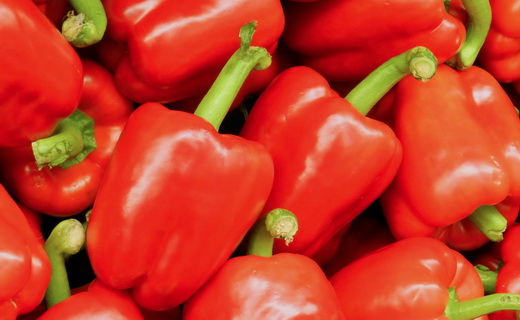 Peppers were brought to Russia in the 16-17th century. In various regions of the country, he did not immediately take root, since the climatic conditions for pepper should be soft, without drastic changes. After some time, in the middle zone of the country and the northern part of the pepper began to grow under shelters.
Peppers were brought to Russia in the 16-17th century. In various regions of the country, he did not immediately take root, since the climatic conditions for pepper should be soft, without drastic changes. After some time, in the middle zone of the country and the northern part of the pepper began to grow under shelters.
What are the best varieties of peppers for the Moscow Region for growing in greenhouses, you can find out from the review.
Content
Description and benefits of growing pepper in greenhouse conditions
You can get the maximum yield of pepper only in greenhouse conditions. In the closed ground, it is possible to create and maintain stable conditions, which cannot be done in open ground. Pepper loves heat, so you need to constantly maintain optimal temperature and humidity. Peppers can be grown in greenhouses from a dense film, glass or polycarbonate.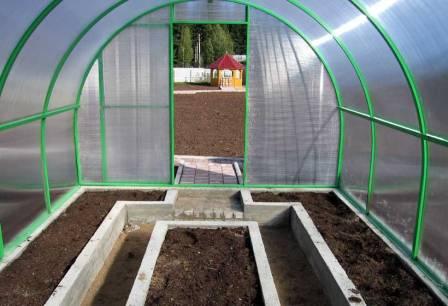
Optimal microclimate in the greenhouse:
- Temperature mode + 23-26 degrees. With constant maintenance of the temperature, the plants will quickly gain green mass and begin to bear fruit.
- Pepper is quite a hygrophilous plant, so the humidity should be in the range of 60-70%. Sharp changes in humidity are detrimental to the inflorescences and fruits of the plant. Special thermometers will help monitor temperature and humidity.
- Pepper loves the light. If there is insufficient sunlight in the greenhouse, it is worth installing artificial light sources. Lack of light will cause growth retardation and yield deterioration.
- Peppers should be planted in neutral, light soil with a high content of organic fertilizers.
Why is it worth growing peppers in greenhouse conditions? Consider the benefits of growing in greenhouses: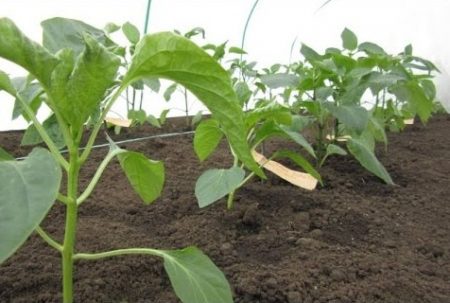
- pepper can be grown very early;
- constant maintenance of the microclimate allows you to protect plants from the aggressive conditions of an open climate;
- diseases and pests in the greenhouse appear less often than in open soil;
- fruit ripening rate faster than on exhaust gas;
- do not require hardening;
- care for adult plants is minimal.
The best varieties of sweet pepper for the greenhouse
- "California Miracle" - ripens for 100-130 days, which indicates that the pepper is mid-season. A garden crop grows low, up to 50 cm. Up to 10 pieces are formed on a small bush. Cube-shaped pepper, weighs 80-140 grams. Ripe fruits stand out in rich red.
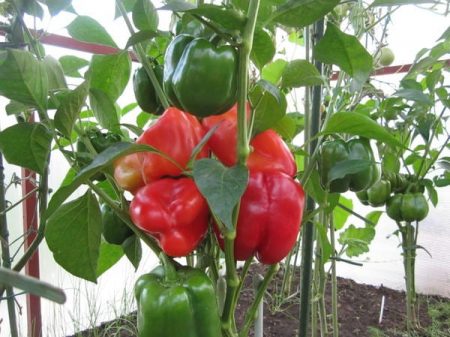
- Arsenal is a semi-spreading pepper with a ripening period of 125-130 days. Cone-shaped fruits grow in weight 90-120 g. The peel of the fruit is painted in ruby color. Productivity is stable, bushes grow within 45-80 cm.
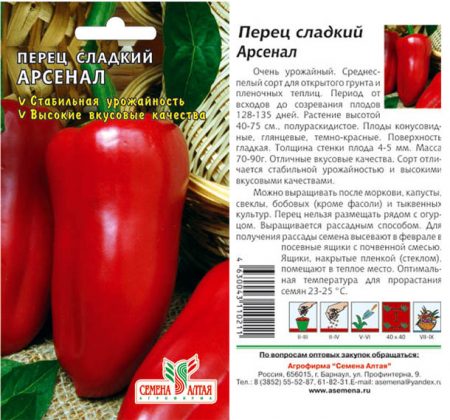
- Cow's Ear. Aelita and Altai Seeds companies represent this variety as large-fruited peppers with excellent storage and transportability indicators. The fruits reach a length of 10-12 cm. The smallest mass is 100-120 g., The largest is 150-160 g. The plant grows 0.6-0.7 m. Pepper begins to bear fruit 70 days after transplanting.
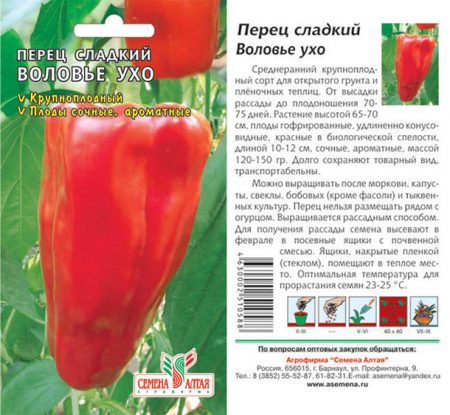
- "Hercules" - a late variety of pepper, which stands out for its massive cuboid shape of the fruit. Vegetables reach full ripeness on the 95th day after transplanting. Peppercorns weigh 150-300 g, grow 11-12 cm in length. It has excellent taste, appreciated for its attractive appearance. A sign of ripe vegetables is cherry blossom.
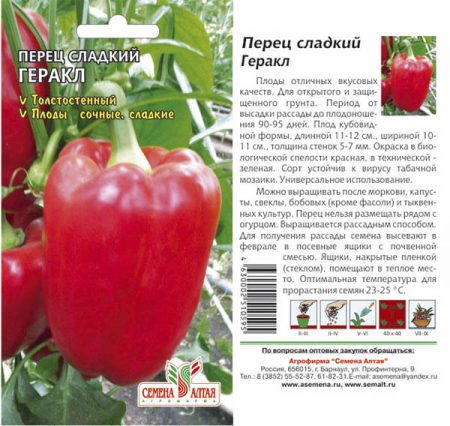
- "Orange King" is included in the state register of the Russian Federation for cultivation on closed soil. 4 kg are collected from one square meter. Ripe fruits of saturated orange color, weighing 120-150 grams, cubical shape.Bushes grow semi-sprawling mid-height.
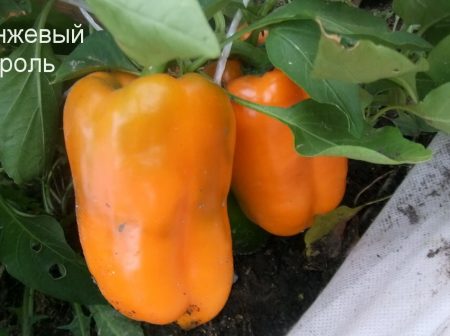
- Bagira will surprise with its chocolate color and large-fruited. Fruits can reach up to 350 grams or more. Bushes grow undersized, their height does not exceed 50 cm. The flesh is thick-walled 8-9 mm. The variety belongs to early ripening.
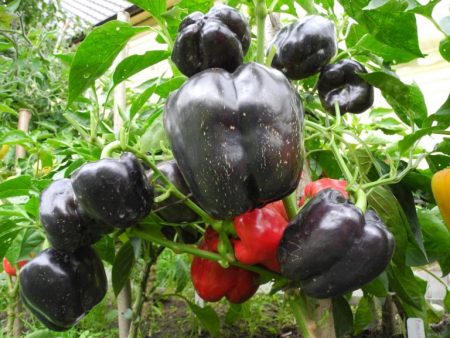
- Golden Calf pepper will delight with its early ripeness, 100-110 days, and weighing 300 g. The walls are thick 10 mm. The height of the plant is 0.9-1.1 m., As you grow, you will need a garter. Vegetables are painted in a sunny orange color. The fruits resemble the shape of a cube.
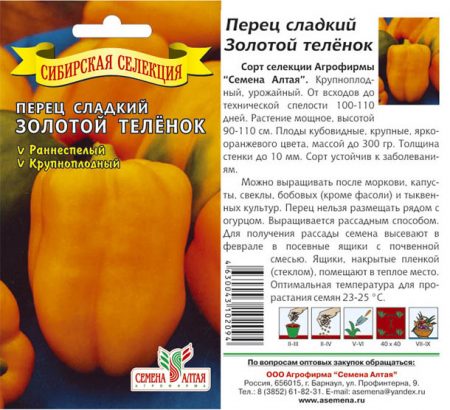
- “Pinocchio” is a variety of pepper with an elongated fruit shape 12-15 cm long. On bushes 0.7-1 m high, cone-shaped peppers weighing 80-120 grams grow. Attracted by their appearance, the ability to store vegetables for a long time and transport over long distances. Ripe vegetables have walls 4-5 mm thick.
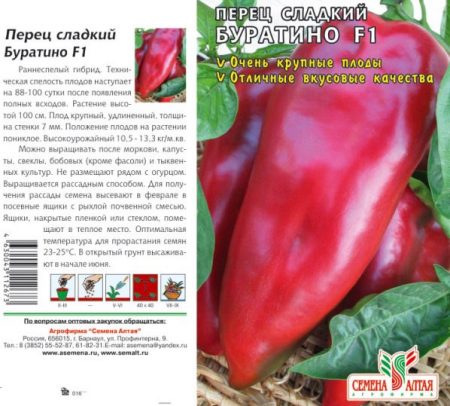
- Pepper "Tenderness" will not surprise you with its red color, but it will please the thick walls of 7-8 mm., The weight of the fruit is 110-130 grams. From one square meter, you can harvest 7-10 kg. Such productivity is justified by a plant height of 1 m or more. Pepper must be tied to a support.
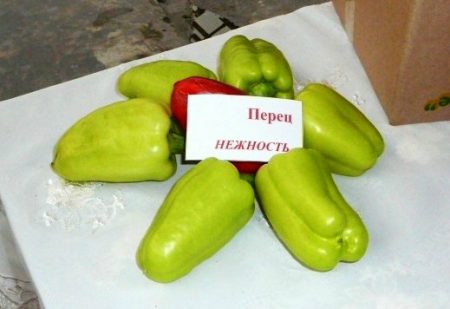
- "Latino" - a variety of pepper, which is attributed to a hybrid origin. Recommended to grow on closed soil. The height of the bushes reaches 100 cm, the plants are medium leafy, but the leaves are large. Fruits well. Pepper grows weighing 200 grams with walls of 10 mm. From 1 m², under all conditions of planting and care, you can collect 14 kg. vegetables.
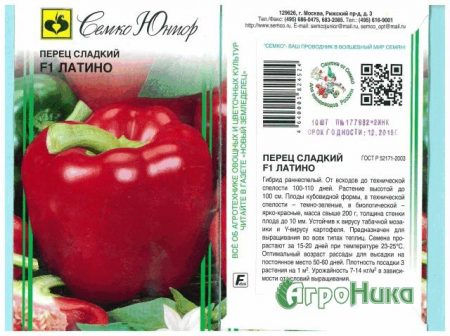
- Pepper variety “Prince Serebryansky” has a complex resistance to diseases. Juicy and tasty fruits can be harvested for 115 days. Technically ripe fruits are light yellow or cream in color, and in biological ripeness the vegetables turn a bright red color. Bushes are low, 50-80 cm. One fruit can weigh 100-120 grams. Under a film cover, 2-3 kg can be collected from one plant. pepper.
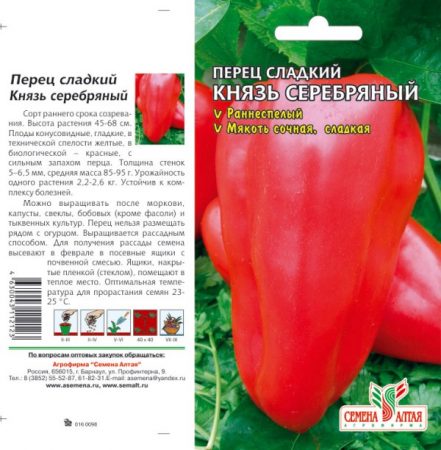
- "Paris" is a pepper that will subdue with its delicate and juicy taste. Fruits are ready for use on day 130-135, after germination of seed material. The skin of the pepper is shiny, which gives it a gloss. Ripe vegetables reach a mass of 120-130 g and have a wall thickness of 6-8 mm. From 8-10 meter plants collect up to 2 kg. pepper. Seeding for seedlings is recommended in February.
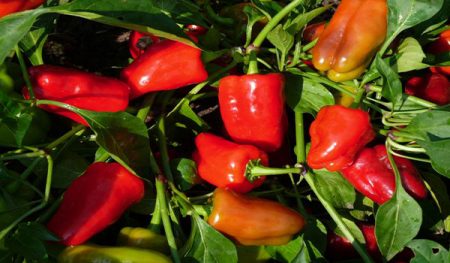
- Hottabych pepper will surprise you with its unusual ivory color and sweet taste. Outwardly resembles hot pepper, the shape of the fruit is elongated, the weight is small, 70-100 grams. On a plant that grows 1.5 m. 14-16 fruits are formed. The walls are not thick, 4-5 mm. Seedlings are planted on 60-65 days from seedlings.
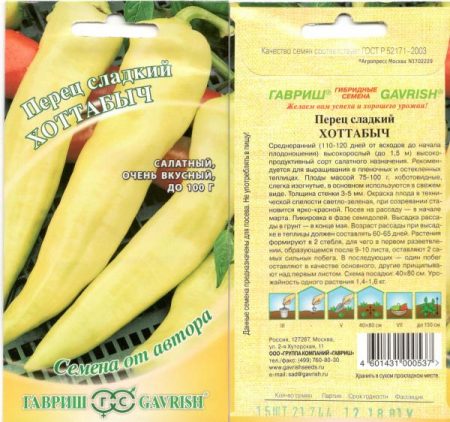
- The variety "Cube-K" stands out for its large fruits, sweet taste without bitterness. The fruits are red, cuboid in shape. Peppers are used for cooking lecho, frozen storage. The mass of vegetables in ripeness is 150-200 grams. Subject to a favorable microclimate in the greenhouse, a yield of 1 m² will be 9-10 kg. You may need a garter to the trellis.
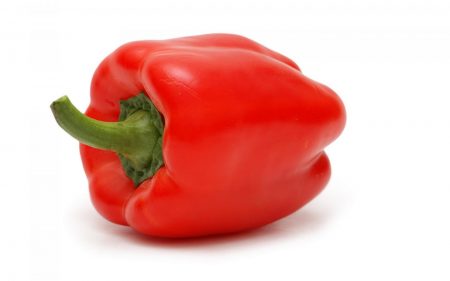
- Cardinal pepper will delight with early ripening and a mass of 250 grams. From germination to technical ripeness, 90 days pass. In height, the plant reaches 1 meter. Productivity from a square meter of 14 kg. The color of the fruit is dark purple or red-violet. The skin is smooth and shiny.
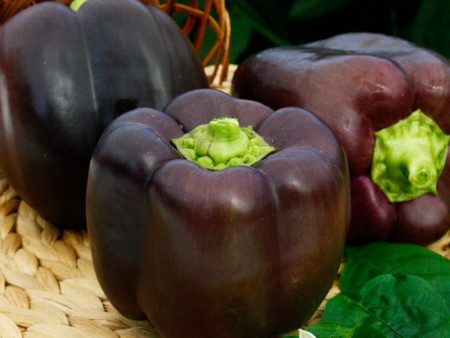
- Ruza is a hybrid variety with a minimum ripening time of 82-105 days from the time of seed germination. Fruits grow to 100 grams, red. Bushes are low. The variety will be pleased with the simultaneous formation of fruits and their ripening together. The fruits resemble a cone. Virtually not susceptible to apical rot and vertilliciosis.
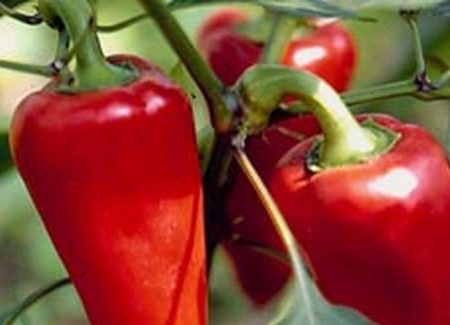
The best varieties of peppers for open ground
- Corvette pepper is bred in two colors: red and orange. Ripening period is 105-115 days. The bushes are spreading, 50-60 cm high. The peel is glossy, the wall thickness is 6-7 mm. The mass of vegetables is 60-80 grams, but the yield from 1 m² is 6-7 kg. Pepper is not exposed to viral diseases.
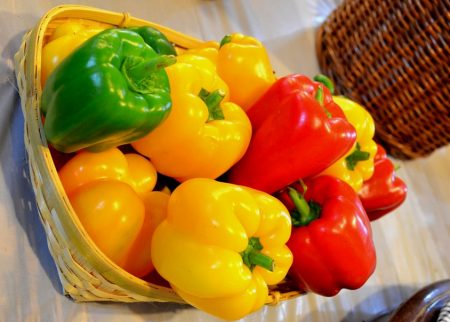
- The variety "Lemon Miracle" pleases with its bright lemon color and excellent taste. The fruits grow 180 g.The thickness of the pericardium is in the range of 6-8 mm. Pepper is resistant to sharp changes in weather conditions, so it is included in the group of the best varieties for open ground.
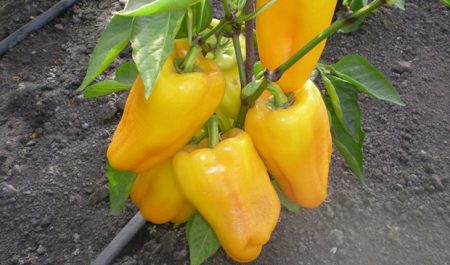
- "Golden Taurus" is a varietal hybrid that has been specially adapted for landing in Siberian conditions on open ground. The bushes are low, 60-75 cm. The fruits resemble barrels, their weight is 250-500 grams. The walls are thick, up to 10 mm. On one plant, up to 14 peppers are tied. The "Golden Taurus" is very massive, perfectly suitable for fresh and canned consumption.
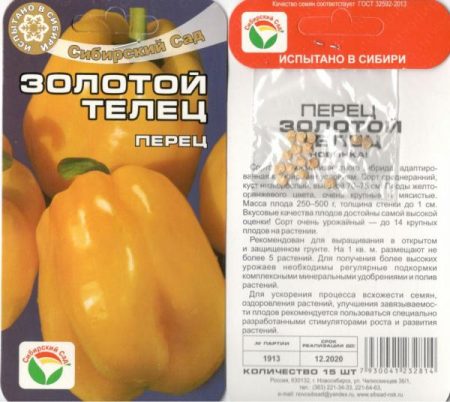
- Pepper "Red Elephant" got its name because of the red color and the length of the fruits, which reach a mark of 22 cm. The shape of the pepper is conical, drooping. Ripe vegetables grow weighing 130-200 grams. The plant is powerful, 80-90 cm high. The crop is 6-7 kg per square meter of plantings. Subject to any culinary and industrial processing.
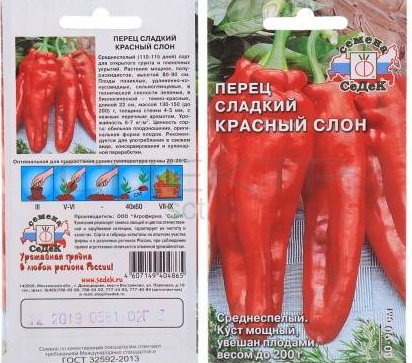
- Pepper "Hercules" is part of a group of universal varieties that give a high yield, both in open soil and closed. The ripening period of the fruit from the moment of transplanting is 90-95 days. Cuboid vegetables, 11-12 cm long. In biological ripeness, they reach a mass of 150-300 grams, the color of the fruits is red.
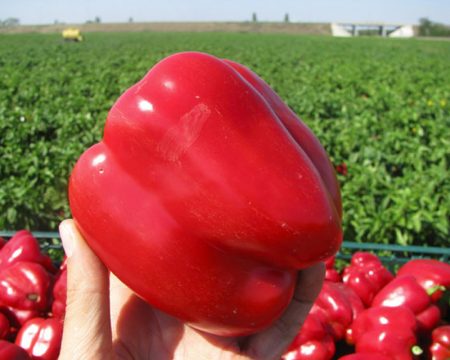
Recommendations for growing sweet peppers in a greenhouse
- Seed preparation is an important part of growing strong plants. What will be the seed, so will the crop. Seed preparation methods:
- calibration of seeds for hollowness. Seeds purchased and collected at home are subject to calibration. This is necessary to determine the seeds with a full endosperm, which will germinate and yield a crop. The calibration process is very simple: dilute 40 grams of kitchen salt in a liter of water and place the seed there. All seeds that emerge need to be collected and discarded, they will not germinate, the remaining ones at the bottom must be dried for further processing;
- disinfection with a one percent solution of potassium permanganate. It is simple to prepare, you will need to dissolve 1 g of potassium permanganate in 100 ml. water, soak the seeds. Etching is carried out for 20 minutes, after which they need to be washed with clean water;
- soak in a growth stimulator to increase resistance and stimulate plant growth. Growth stimulants are very large, for example, you can use "Epin", "Novosil", "Zircon". On each of the preparations it will be written what dosage is used for seed treatment;
- if you buy seeds, it is likely that they have already been pickled, so pay attention to the color of the seeds. Non-etched seed material is yellow or cream, and etched pinkish or other color.
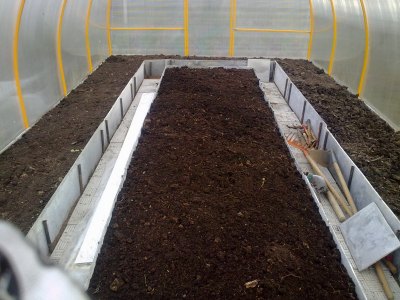
- Sowing seeds. For three days, it is necessary to cultivate the soil with Fitosporin solution to disinfect the soil from various fungi. The seeds are planted in a slightly compacted soil, to a depth of 1-2 cm. Pour seeds with warm water.
- Pick When the seeds sprout and the first two leaves appear, it is recommended to pick a pepper. You need to prepare pots or cassettes in which you will transplant the sprouts. For a dive, it is best to use peat pots to facilitate the planting of seedlings. The plants are still very fragile, so transplant very carefully so as not to break the stem.
- Transplanting seedlings in the greenhouse and in the garden. It is very easy to transplant a picked pepper, for this you need to make holes according to the 40 × 70 pattern and place peat pots in them. Until the transplant, the seedlings should reach a height of 20 cm. Due to the fact that you will not disturb the root system, pepper will adapt much faster and will grow.
Before planting pepper, apply complex fertilizers to the soil that contain the nitrogen component.
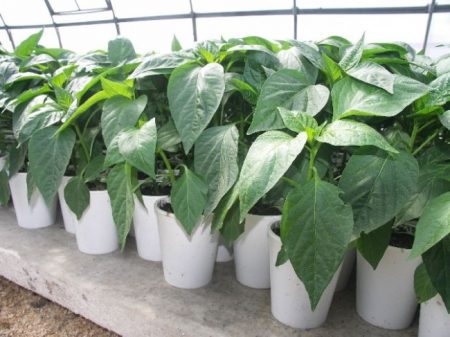
Planting pepper in open soil is the same as closed, only before planting seedlings on the bed, it must be hardened. Hardening is done 10-15 days before the intended planting. This process consists in gradually lowering the temperature in the greenhouse so that plants can quickly acclimatize in open conditions.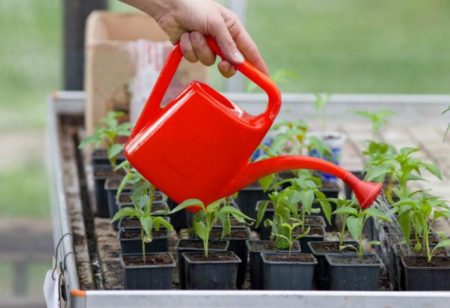
- Watering pepper in a greenhouse must be done in the evening or early in the morning, so that the plants have time to absorb the liquid before the water evaporates under the influence of sunlight. Peppers need to be irrigated no more than twice a week, spending 2 liters per plant. water.
If the soil does not have time to dry out, then the water consumption can be reduced to 1 liter, so as not to provoke a black leg disease. The soil under the plant can be mulched to reduce moisture evaporation.
Reviews:
Pavel Romanovich:
I live in the suburbs, I grow peppers exclusively for my own consumption. For 10 years I have tried many different varieties. The favorites were: Bagheera, Red Elephant, Orange King. I really like the taste of these peppers and the variety of colors. To protect the plants from the weather, I grow them in a greenhouse covered with polycarbonate. Harvest was always satisfied, plants are not prone to diseases.
Stefania Petrovna:
I believe that each kind of pepper is unique and good in its own way. All varieties that I grew in the greenhouse gave excellent yield indicators. But I will single out my favorite - this is the Paris pepper. It is just beautiful, when the fruits are poured, my heart rejoices. Peppers ripen in greenhouse conditions much earlier, so it is very convenient. I wish everyone to find their best grade of pepper!




 Calorie pepper stuffed with meat and rice - BZHU per 100 grams
Calorie pepper stuffed with meat and rice - BZHU per 100 grams Gorky pepper - the best varieties for open ground
Gorky pepper - the best varieties for open ground Hot pepper seeds - the best varieties for open ground and reviews
Hot pepper seeds - the best varieties for open ground and reviews Capsicum tincture for hair - how to use and reviews
Capsicum tincture for hair - how to use and reviews